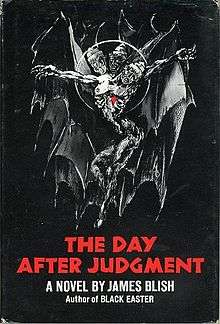The Day After Judgment
 First edition | |
| Author | James Blish |
|---|---|
| Cover artist | Judith Ann Lawrence |
| Country | United Kingdom |
| Language | English |
| Series | After Such Knowledge Trilogy |
| Genre | Fantasy novel |
| Publisher | Doubleday |
Publication date | 1971 |
| Media type | Print (Hardcover & Paperback) |
| Pages | 166 pp |
| OCLC | 1562480 |
| Preceded by | Black Easter (1968) |
The Day After Judgment Is the second of a pair of short novels by James Blish. The first is the novel Black Easter. They have more recently been published as a single book called The Devil's Day.
Plot summary
Black Easter and The Day After Judgment were written with the assumption that the ritual magic for commanding demons, as described in grimoires, actually works.
In the first book, a wealthy arms manufacturer comes to a black magician, Theron Ware, with a strange request: he wishes to release all the demons from hell for one night to see what might happen. The book includes a lengthy description of the summoning ritual, and a detailed description of the grotesque demons as they appear. Tension between Ware and Catholic white magicians arises over the terms and conditions of a covenant that provides for observers and limitations on interference with demonic workings. Black Easter ends with Baphomet announcing to the participants that the demons can not be compelled to return to hell: the War is over, and God is dead.
The Day After Judgment develops and extends the characters from the first book. It suggests that God may not be dead, or that demons may not be inherently self-destructive, as something appears to be restraining the actions of the demons upon Earth. In a lengthy Miltonian speech at the end of the novel, Satan Mekratrig explains that, compared to humans, demons are good, and that if perhaps God has withdrawn Himself, then Satan beyond all others was qualified to take His place and, if anything, would be a more just god.
It has been suggested that Blish got the name for his black magician from the titular character in Harold Frederic's 1896 novel, The Damnation of Theron Ware.[1]
The events end in a battle of men against demons in Death Valley, which ends in the supernatural place disappearing and leaving the characters in "the modern town of Badwater", as if Blish had written this part of the story working from a map and had mistaken the map symbol at Badwater Basin for a town symbol.
Grimoires and Assorted Texts Mentioned
Blish claims in his foreword that all of the texts referenced in the novel are authentic magical texts. Here is a complete list of the books as referenced in the book. Obviously some are secular texts, but most are not.
- Malleus Maleficarum by Heinrich Institor and Jacob Sprenger
- The American Weekly
- Ardshi Bordschi Khan
- Siddhi Kur
- Skaskas
- The Divine Comedy
- Talmud
- Midrash
- Perspectiva by Roger Bacon
- Gospel of Matthew
- Book of Job
- Lemegeton by Rabbi Solomon
- Grimorium Verum
- Grand Grimoire
- Comte de Gabalis
- The Black Pullet
- The White Devil by Webster
- The City of God by St. Augustine
- Confessions by St. Augustine
Notes
- ↑ Ketterer, p. 298
References
- Ketterer, David (1987). Imprisoned in a tesseract: The Life and Work of James Blish. Kent State University Press. ISBN 978-0-87338-334-9.